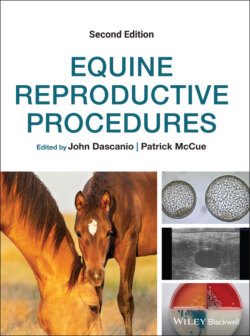Читать книгу Equine Reproductive Procedures - Группа авторов - Страница 21
Оглавление10 Speculum Examination of the Vagina
John J. Dascanio
School of Veterinary Medicine, Texas Tech University, USA
Introduction
A visual vaginal examination should be performed as part of a complete mare breeding soundness examination. A speculum examination may also be used to confirm the stage of the mare’s estrous cycle and to observe the vagina for pathology such as urine pooling, varicosities, adhesions and cervical inflammation, or discharge. A disposable aluminum foil‐covered tube speculum, a glass tube speculum (Figure 10.1), or a tri‐valve Polansky (Caslick) speculum (Figure 10.2) may be used for the examination. The glass tube speculum tends to transmit more light into the vagina than the disposable aluminum tube speculum. The tri‐valve Polansky (Caslick) speculum will provide a wider view of the cranial vagina and cervix, but may obscure the vagina in areas corresponding to the speculum arms.
The mare should have a relaxed external cervical os lying on the floor of the cranial vaginal vault and a pink, glistening vaginal mucosa during estrus. During diestrus, the external cervical os will be toned or closed and located high on the cranial wall of the vaginal vault, with a pale pink, dull, or dry vaginal mucosa. In anestrus, the cervix may be relaxed with a pale, dry mucous membrane. There should not be any discharge from the external cervical os and there should be no fluid accumulation on the floor of the vagina (e.g., urine pooling). The longer the speculum is in the vagina, the more air will irritate the mucosa, causing the mucous membranes to become redder and more congested. Infection may cause an increase in vascularity and redness to the vagina and yellow to white discharge may also be present from the cervical os. During pregnancy, the vagina will often have thick mucus present causing the vaginal walls to stick together. In addition, the cervix during pregnancy may have an accumulation of thick mucus visible (mucus plug).
Equipment and Supplies
Tail wrap, tail rope, non‐irritant soap, roll cotton, stainless steel bucket, disposable liner bag for bucket, paper towels, exam gloves, sterilized glass speculum or disposable aluminum foil speculum, sterilized tri‐valve Polansky (Caslick) speculum, sterile lubricant, light source, uterine culture swab, bacterial/fungal transport media.
Technique
Remove feces from the rectum.
Place a tail wrap and tie the tail out of the way (see Chapter 4).
Clean and dry the perineum of the mare (see Chapter 3).
Lubricate the end of the speculum with sterile lubricant. With the tube speculums, lubricant should not get into the lumen of the speculum so as to avoid obscuring visualization of the reproductive tract.Figure 10.1 Use of a glass vaginal speculum.Figure 10.2 Inserting a tri‐valve Polansky (Caslick) speculum.Figure 10.3 Turning the wing nut to open the tri‐valve Polansky (Caslick) speculum.
Wearing exam gloves, separate the lips of the vulva and insert the speculum in an upward manner to pass over the ventral pelvic brim.
Once over the brim, bring the speculum to a horizontal orientation. Caution is advised when elevating the speculum to a horizontal plane as some mares will react when pressure is placed onto the perineal body.
The tri‐valve Polansky (Caslick) speculum is initially turned sideways to allow entry into the vulva (Figure 10.2) and then turned 90 degrees once over the then pelvic brim and past the vestibulo‐vaginal fold. The tri‐valve Polansky (Caslick) is advanced into the vagina and then opened by twisting the wing nut to extend the three arms outward (Figure 10.3).
Some resistance will be encountered at the level of the vestibulo‐vaginal fold. Slight forward pressure with some slight rotation will allow the speculum to enter the vagina.
A light source is used to visualize the walls of the vagina and the cervix. The tube speculum may need to be moved in all directions and pushed inward or pulled outward to visualize all structures.
Any purulent discharge should be sampled using a sterile uterine culture swab and submitted for bacterial/fungal identification in appropriate transport media.
Visualization should continue while the tube speculum is removed from the vagina and vestibule.
Interpretation
The vaginal membranes and cervix should appear as per the stage of the mare’s estrous cycle.
There should not be a purulent discharge from the cervix (Figure 10.4).Figure 10.4 Discharge through the external os of the cervix in a mare with a pyometra.Figure 10.5 Urine in the cranial vaginal vault.
There should not be any fluid accumulation on the floor of the vagina (Figure 10.5).
No defects should be noted in the vagina or cervix such as adhesions, tissue disruption, or masses (Figure 10.6)Figure 10.6 Adhesions covering the cervix of a mare secondary to a dystocia.
The speculum should be examined upon removal for any abnormal discharges present on its surface.
Further Reading
1 Dascanio JJ. 2011. External reproductive anatomy. In: McKinnon AO, Squires EL, Vaala WE, Varner DD (eds). Equine Reproduction, 2nd edn. Ames, IA: Wiley Blackwell, pp. 1577–81.
2 Pascoe RR. 1979. Observations on the length and angle of declination of the vulva and its relation to fertility in the mare. J Reprod Fertil Suppl 27: 299–305.
